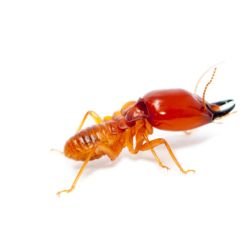Termites

Identification
These tiny insects have soft bodies that are creamy white or light brown in colour.
Most termite species range in size from 1/8 to 1 inch long.
The head contains their mouthparts, eyes, and antennae, which they use to communicate with each other through chemical signals. The thorax is where their legs and wings attach.
Get A Free Quote
We are affordable Pest Control Service in GTA & Surroundings Areas.
What are termites, where do they live, and what do they eat?
Termites are small, winged insects that belong to the order Isoptera. These pests have been around for millions of years and are known for their destructive nature. They live in colonies that can number in the thousands or even millions, with each termite serving a specific role within the colony.
Termites are found worldwide, but they tend to thrive in warm, humid environments. They often build their nests underground or inside trees and dead wood. However, some species of termites can also be found above ground and even inside buildings.
Termites feed on cellulose-based materials such as dead plant matter and wood. This is why they are notorious for causing damage to homes and other structures made of wood. Termites can quickly chew through wooden beams, flooring, furniture, and other objects made from cellulose-based materials if left untreated. It’s important to take preventative measures against termites by regularly inspecting your home for any signs of infestation and seeking professional help if necessary.
Safeguard your home against the silent threats of termites and weevils with our expert tips on pest prevention and control.
What are the different types of termites?
Canada may not be known as a termite hot spot, but various species can be found throughout the country. The most commonly encountered types of termites in Canada are damp wood, drywood, and subterranean termites.
Damp wood termites thrive in moist environments and are typically found in coastal regions or areas with high levels of precipitation. They are larger than other termites and prefer to feed on rotting or decaying wood.
Drywood termites are often found in dryer climates and prefer dry, sound wood. These termites can cause significant damage to homes as they do not require contact with soil and can infest multiple areas of the home simultaneously.
Subterranean termites live underground and build mud tubes to access above-ground food sources such as wood structures. They are highly destructive pests that can cause extensive damage if left untreated.
Regardless of the type of termite present, it is important to address any infestation promptly, as these pests can quickly cause costly damage to homes and other wooden structures.
What are the differences between termites and ants?
Termites and ants may be similar in size and appearance, but they are two completely different insects. While ants belong to the family Formicidae, termites belong to the Isoptera family. One of the most notable differences is that termites have straight antennae, whereas ants have elbowed ones.
Termites also tend to be more destructive than ants as they feed on wood and can cause extensive damage to buildings if left untreated. They live in large colonies with a hierarchical social structure, while ant colonies are typically smaller and less complex. Another difference lies in their wings; termites have four wings of equal size, while flying ants have larger front wings than their hind wings.
If you suspect your home has a termite infestation, it’s crucial to get professional help immediately, as they can quickly cause irreversible damage. On the other hand, if you’re dealing with an ant problem, using baits or traps could help eliminate them without causing harm to your property.
Impact: What are the consequences of termite damage?
Termite damage can have severe consequences on both residential and commercial properties. It can lead to structural problems, such as weakening the foundation, walls, ceilings, and floors. This can be a huge safety hazard for those living or working in the affected building.
Apart from structural issues, termite damage also affects the aesthetic appeal of a property. Wooden furniture, fixtures, and other wooden items are more prone to termite infestation than any other material. The presence of holes in these items due to termite damage makes them look unattractive and shabby.
Furthermore, termites are known for their destructive feeding habits, which can cause significant financial losses to homeowners or businesses that own wooden structures or items. Repairing damages caused by termites is an expensive affair that may require extensive reconstruction work, which means a loss of time and money spent on repair costs.
In conclusion, homeowners or businesses must take preventive measures against termite infestation before it becomes too late. Regular inspection by professionals will help identify signs of termite activity early enough so that appropriate action can be taken to minimize any potential damage caused by these pests.
Residential Pest Control Service
Customized pest control treatments can be used to safeguard your living space against bothersome pests and ensure that they don’t become a nuisance in your home.
How can you identify and treat termite damage?
Identifying and treating termite damage is crucial to maintaining your home’s or building’s structural integrity. Signs of termite damage include:
- Hollow-sounding wood.
- Weakened floors and walls.
- Tunnels in wood or drywall.
- Discarded wings near windowsills or doors.
If you suspect a termite infestation, acting quickly before the damage becomes irreparable is important.
One effective treatment for termite damage is using a liquid termiticide. This involves drilling holes into the infested areas and injecting the solution directly into the wood. Another option is bait stations, which use slow-acting toxins that are taken back to the colony by worker termites.
